 Image Credit: Marcos Castillo and Shutterstock.[/caption]
Image Credit: Marcos Castillo and Shutterstock.[/caption]
The United States is no stranger to Hispanic food; eateries across America are constantly updating their menus and offering delightful foods they consider Hispanic. Many restaurants and cafes focus solely on a Hispanic menu and claim to serve authentic Hispanic recipes passed down from generation to generation.
However, most of the food served here has been Americanized to some extent. Most people who love Hispanic food aren’t aware of the exciting culture that birthed Hispanic cuisine and aren’t even aware what they’re eating might not be authentic Latin American foods.
Hispanic culture is quite diverse, including bits and pieces of music, art, gastronomy, and beliefs from various nations. This means it’s also incredibly broad and multifaceted and can be experienced in many places, especially during Hispanic Heritage Month, which starts on September 15 and ends on October 15. During these 30 days, there are celebratory events, exhibitions, concerts, performances, lectures, and food-related affairs.
What is Considered Hispanic?
While most believe Hispanic solely refers to Spanish-speaking nations, the history is a little complex. The term Hispanic derives from the Latin word “Hispanicus,” which the Romans used to refer to the inhabitants of the Iberian Peninsula. Although the peninsula contains Spain, Portugal, Gibraltar, Andorra, and a portion of France, the term Hispanic specifically refers to Spaniards.
However, over the years, the term has evolved to describe nations that speak Spanish or those which, in one way or another, are related to ancient Spain.
This is where it gets complex; Spaniards migrated to and colonized several portions of South America, the Caribbean, Central America, and Mexico. As a result, the term Hispanic was used synonymously for the people of Latin America, although there are minor differences.
Hispanic generally refers to countries and nations that converse in Spanish, while Latin American refers to the nations that may hold Hispanic ancestry but also converse in Portuguese and French. Contrary to popular belief, the terms are not interchangeable.
However, a Latin American can be Hispanic, although that is not always the case.
What are Hispanic Countries?
Nations that primarily speak Spanish are considered Hispanic. They include Spain, Mexico, Panama, Cuba, Dominican Republic, Puerto Rico, Costa Rica, Nicaragua, Guatemala, El Salvador and Honduras.
These nations may also be considered Latin American, although the term generally refers to nations like Argentina, Bolivia, Chile, Colombia, Uruguay, and Venezuela.
While the terms Hispanic and Latin American are not interchangeable, their culture may merge or be extremely similar, especially when it comes to food.
26 Popular Hispanic Foods
Hispanic food culture is extremely diverse, but a few popular Hispanic foods make the cut. Some featured dishes have been commonly served across Hispanic and Latin American nations, while others are even served in the United States.
However, some dishes have undergone some changes due to the variety of Hispanic culture, so a brief comparison with the authentic recipes will also be discussed.
1. Empanadas: Spain, Portugal and Mesoamerica
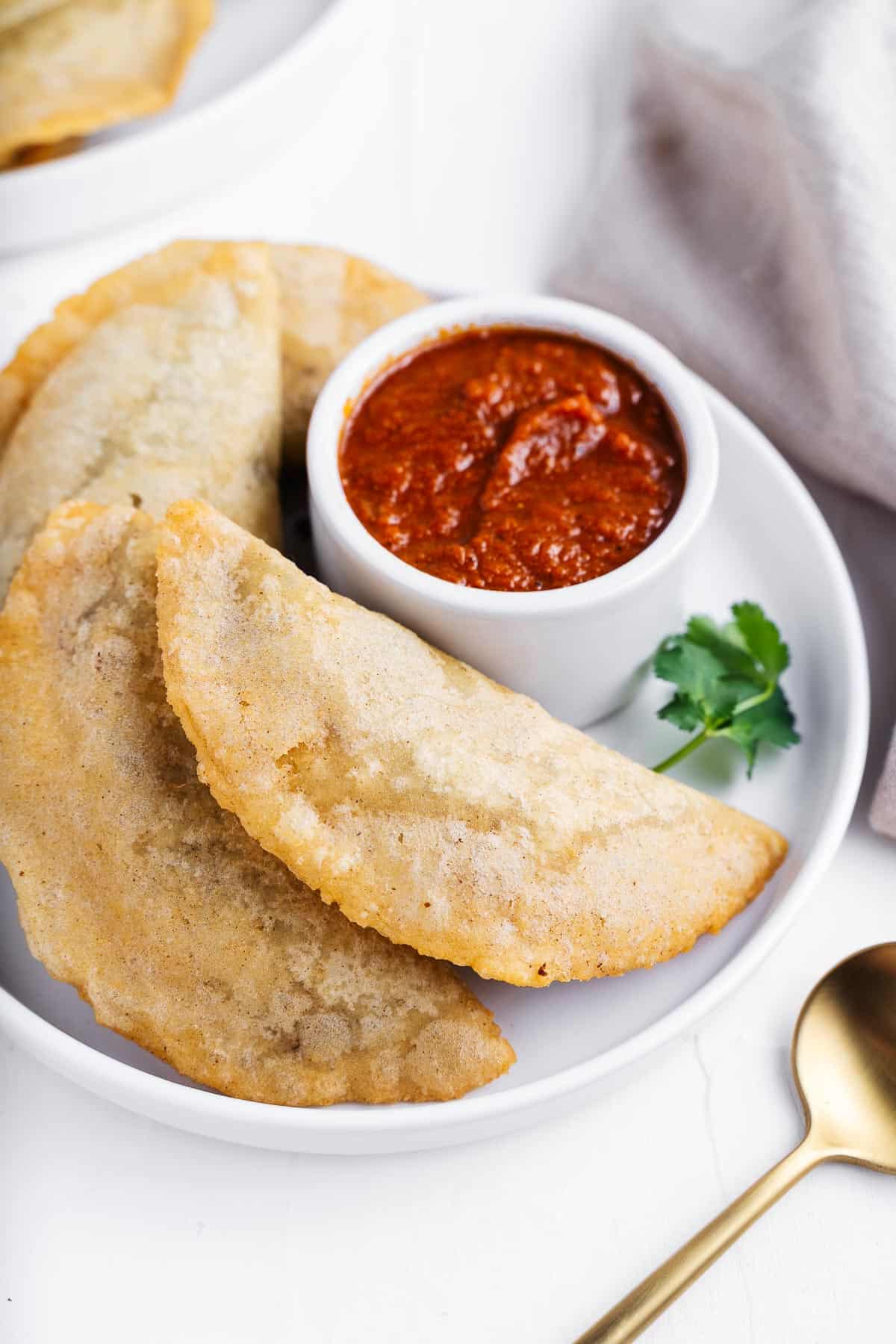
One of the most popular Hispanic foods in the United States, empanadas are a heavenly mix of meat, vegetables, and fruit stuffed fried/baked into a dough ball.
Empanadas originated in Spain but might have roots in Portugal.
Traditional recipes use chorizo or tuna as filling, while Americanized versions use lighter fillings like chicken, beef, or pork. Instead of the smaller pouch, like empanadas that are served in America, traditional recipes baked them as big pies that would later be cut into pieces. They also used corn-based dough instead of flour-based.
The variety intensifies across nations, so there’s really no one way to make them, be it vegan empanadas or with ground beef.
2. Paella: Spain
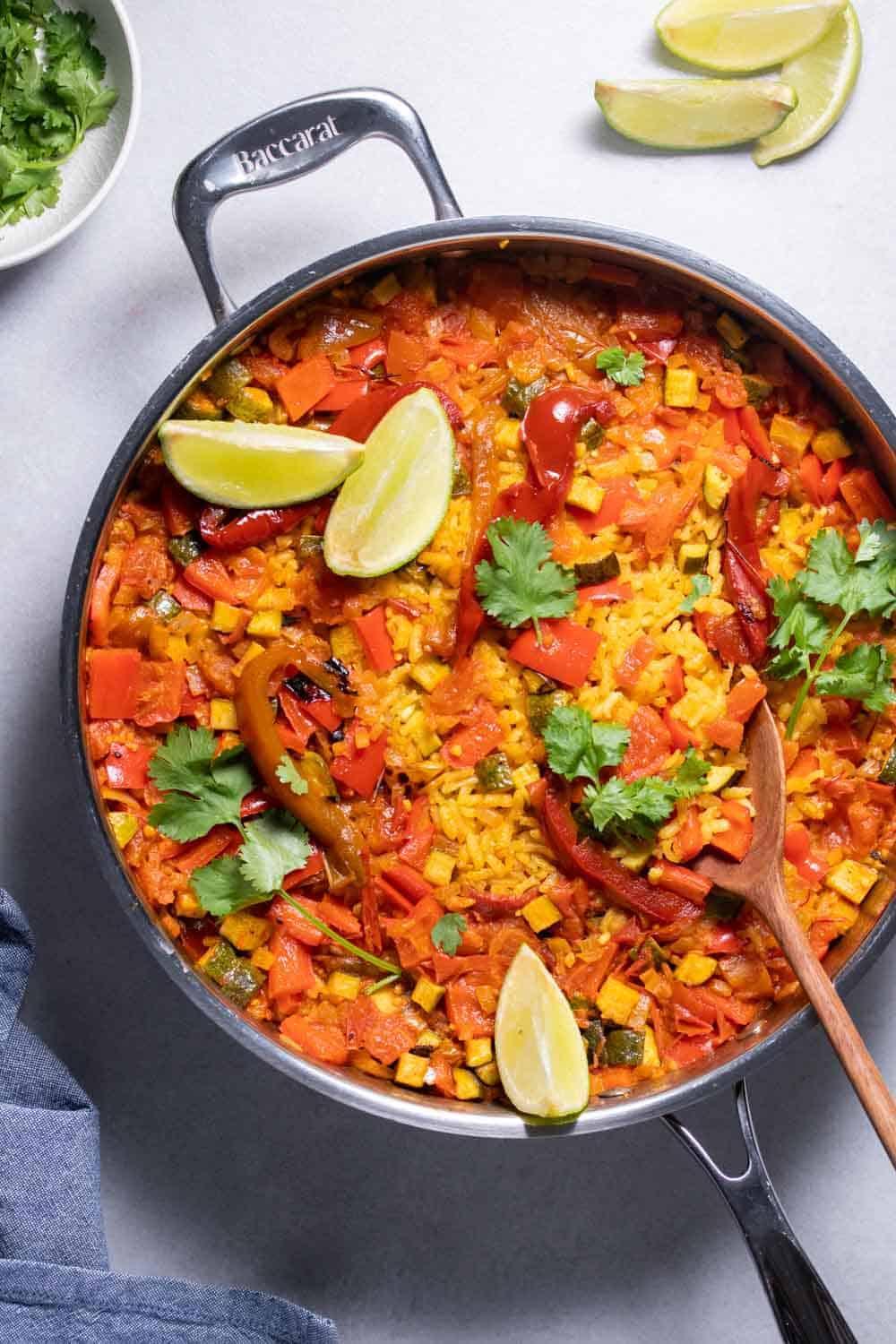
Hailing directly from Valencia, Spain, paella is a delectable mix of rice, seafood, vegetables, beans, chicken, and the very expensive saffron. Yet, the dish most people eat joyously today didn’t always include such ingredients; traditional recipes featured rabbit or duck cooked with lima beans in broth.
The drastic change came from fishermen along the Mediterranean coast, who used available seafood to make the simple dish.
In America, common protein replaced traditionally preferred meat, while spices were ditched in favor of simpler ones. In the U.S., only a few eateries honor the original recipe, although modified versions are also considered authentic Hispanic food to an extent, like this vegan paella.
3. Pupusa: El Salvador and Honduras
Commonly served in Honduras and El Salvador, the dish is so popular that the latter declares it its national dish.
Pupusa are thick cornmeal or rice flour flatbreads stuffed with meat, cheese, or bean fillings. Often confused with Mexican tortillas, pupusas are commonly served in the U.S., but different versions exist.
This traditional Hispanic dish has different variations; Honduran pupusas use local cheese, while American versions feature new ingredients like pepperoni and spinach.
Although simple, pupusas are incredibly nutritious and delicious, so they’re worth a try.
4. Tortilla Soup: Mexican
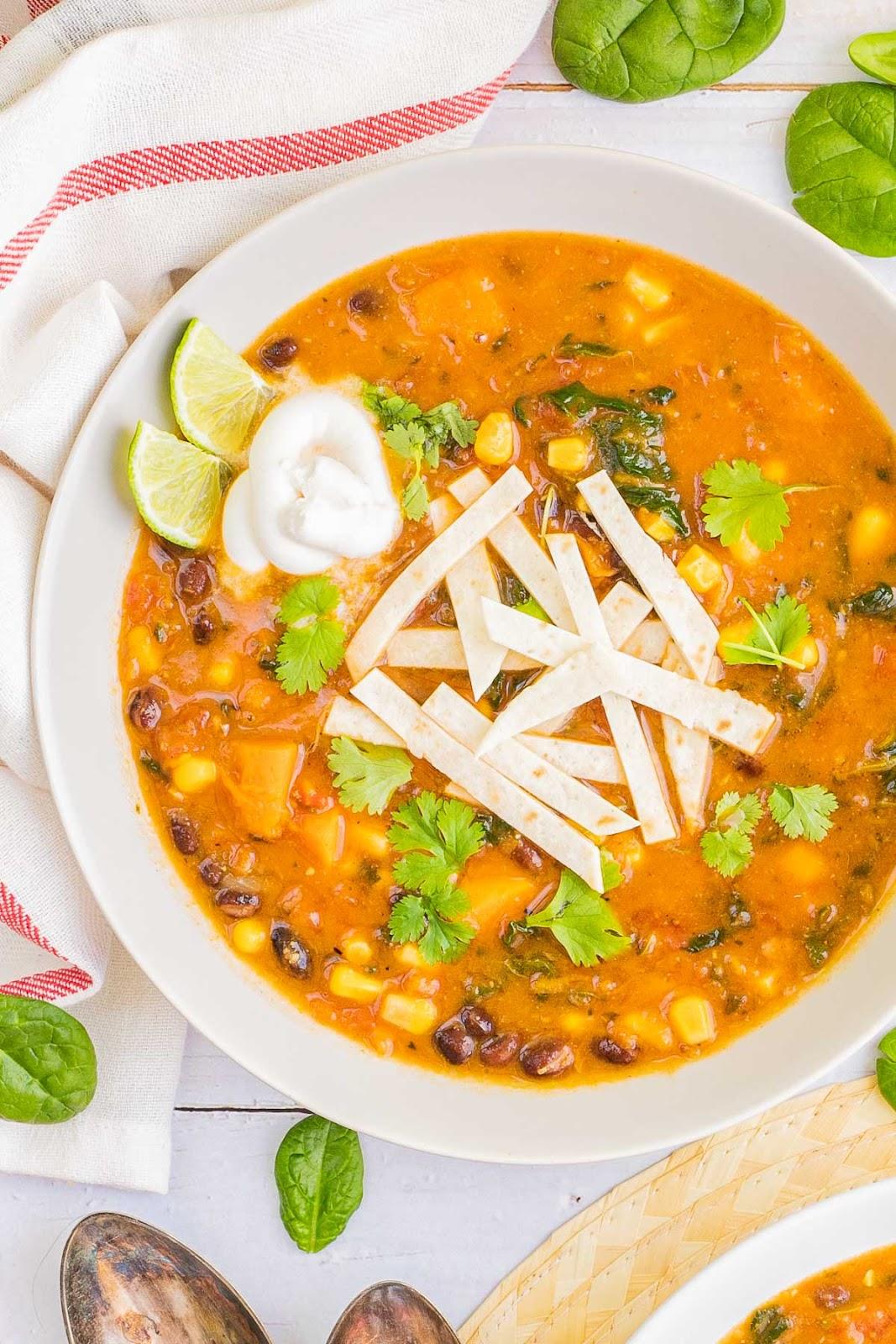
As the name says, tortilla soup is considered a staple in Mexico, especially in cold weather. However, there are many variations of this recipe. The most famous one is with chicken in it. You can add beans, and it becomes “Tarasca,” and if you don’t want to put chicken in the soup, then you can call it “Azteca” soup.
The recipe includes fried tortilla strips that are used for garnishing, along with avocado, lime, chicken breast, cheese, and table cream. The soup itself is made from roasted tomatoes, garlic, onion, ancho chili, and various spices mixed in chicken stock.
The American version also has many different types. The most famous one involves cooking all veggies and chicken breast in stock and serving it with toppings.
If you don’t like to use meat, try vegan tortilla soup, which is as flavourful as the meaty version.
5. Gallo Pinto: Costa Rica
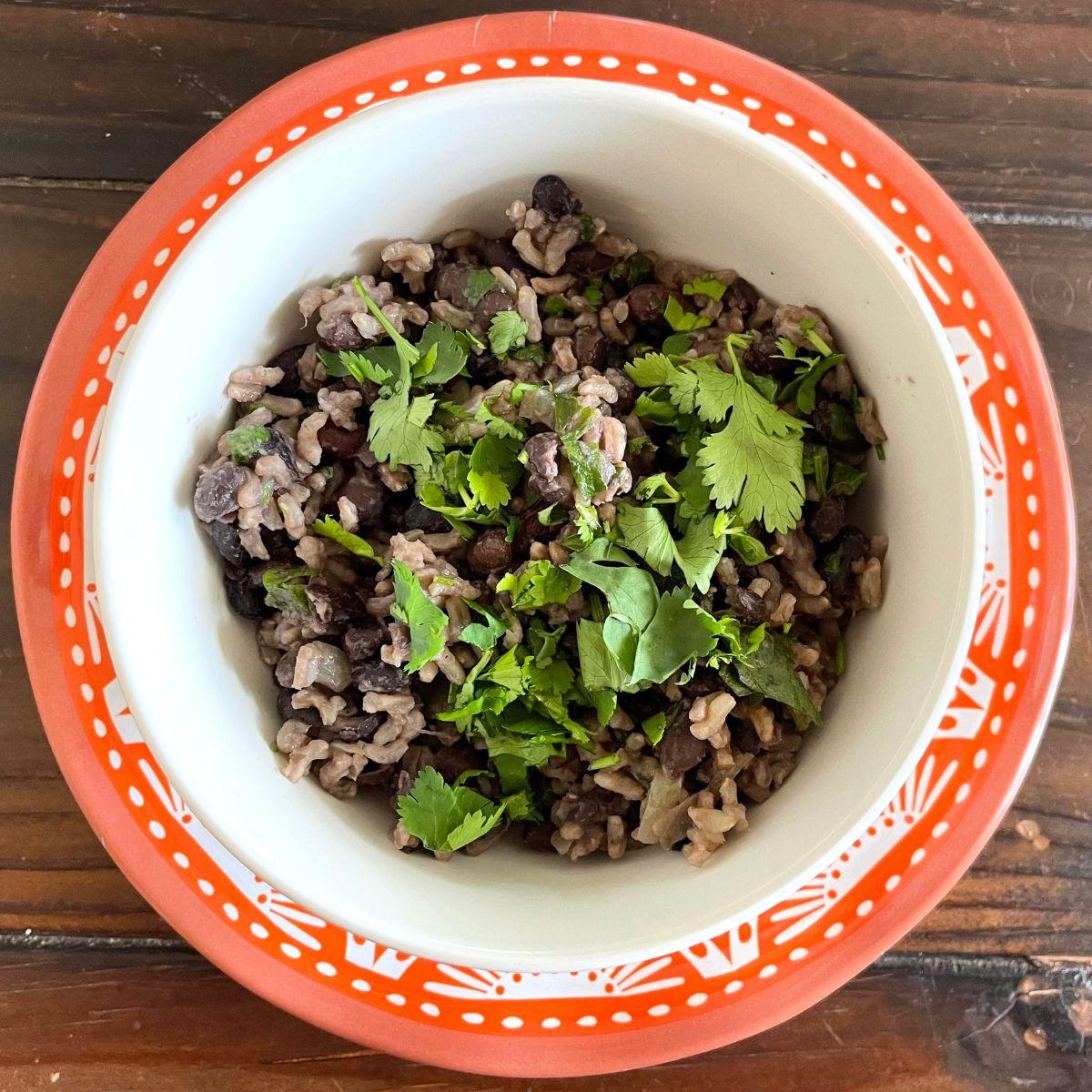
Although gallo pinto is considered a Central American dish, most of its history is linked to Costa Rica and Nicaragua. Gallo pinto is a light and nutritious rice and bean dish, which naturally comes with a few variations since it uses Latin American staple ingredients.
Costa Rican gallo pinto comes in two ways; the first is moist and dense and features onions, cilantro, and chili, while the second is a thicker, roasted red bean version.
In Nicaragua, the dish uses onions and red beans and is a common street food. Other Hispanic nations like Honduras put their twist on gallo pinto, but traditional recipes have held up and are found even in American food chains.
6. Taco: Mexico
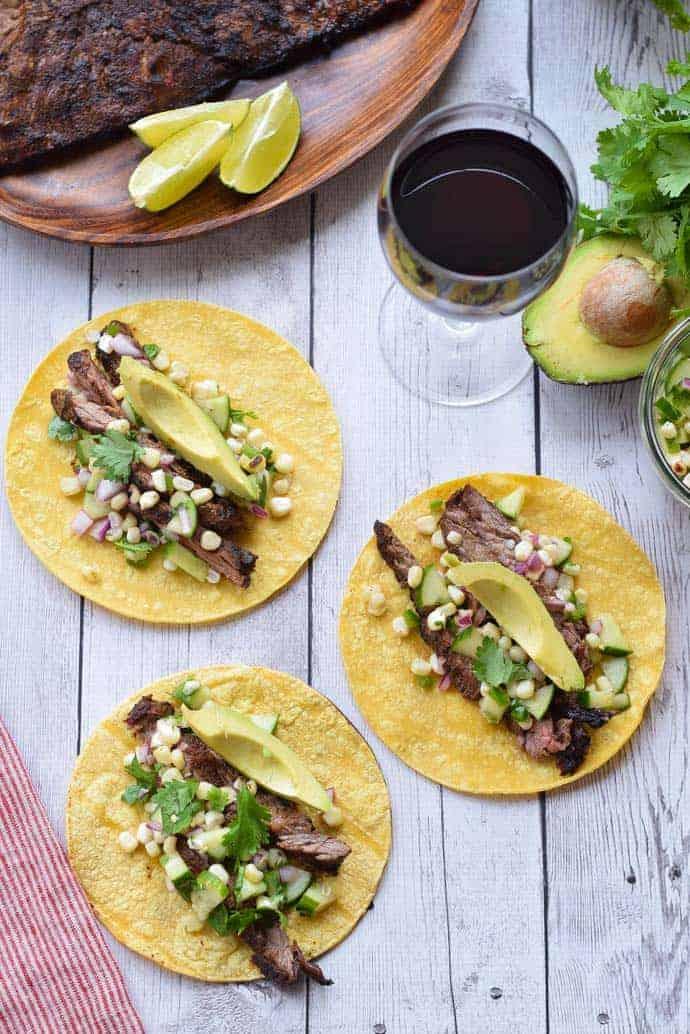
Perhaps the only dish on the list that needs no introduction, tacos are exclusively considered a Mexican dish. Their extreme popularity in the U.S. has given rise to Americanized variations, which contain only a few of the original elements.
The finger-licking good Tex-Mex tacos typically served in America have a crispy corn shell, almost similar to chewy crisps. Some variations are made with a soft-shell tortilla, and these are the ones that pay homage to their Mexican routes.
Traditional taco recipes use roasted meat with onion and cilantro, while Tex-Mex uses cheese, a mix of fajita vegetables, and ground beef, like grilled steak tacos.
Foodies might also want to try cauliflower tacos. They’re equally delicious in their own ways, although traditional tacos are zestier and have a stronger kick.
7. Ceviche: Peru, Ecuador
Simple but flavorful, ceviche is yet another Hispanic delicacy that’s served in Latin American countries and has made its way to other countries as well. Ceviche is said to have originated in Peru and Ecuador, although it’s unclear who holds the honor.
Ceviche is a humble dish: shellfish or seafood chopped up and marinated in citrus. It may not sound too appetizing, but its vibrant looks can barely compete with its intense flavor.
The most popular variation is ceviche de camarones, or shrimp ceviche, served in Ecuador and Peru. Ecuadorian ceviche includes cilantro and red onion, while Peruvian ceviche de camerones contains sweet potatoes as well. They’re equally amazing, so finding a personal favorite is easier said than done.
8. Spanish Omelet: Spain

The thick, fluffy breakfast item commonly served across US diners is an even bigger deal in its homeland, Spain. Spanish omelet is a delicious concoction of eggs, potatoes, and oil and is a tapas served as an appetizer or a main course.
Spanish omelets served in the United States only slightly differ from traditional recipes because they contain ingredients like tomatoes, cheese, parsley, and other herbs. They also replaced olive oil with other vegetable oils. Traditional Spanish omelets contain only a few ingredients and still deliver a flavorful kick with each bite.
9. Mofongo: Puerto Rico
Travel to Puerto Rico, and the streets will be lined with eateries serving mofongo.
Mofongo is a vegetable-based meatball-type dish; cooked plantains are mashed with garlic, olive oil, and meat/poultry broth before being shaped into balls. The plantain balls are then filled with pork or bacon and then fried and served with a rich broth soup.
Interestingly, mofongo might not be Puerto Rico’s brainbaby. Some say it hails all the way from Africa, whose dish fufu has similar origins. Yet there’s no certain way of knowing which dish birthed the other. Amazingly, mofongo has different variations across Hispanic nations as well, which use several ingredients, including cheese.
10. Baleadas: Honduras
Believed to have come from Honduras, baleadas are often confused with tacos because they’re visually the same. Yet, Honduran baleadas are softer and contain salted cheese, fried red beans, and a cream made from mantequilla (Honduran butter). This unique combination of ingredients distinguishes it from the well-known tacos, and those who try it aren’t disappointed.
In Honduras, baleadas are quite significant since they mask a dark past. According to legends, a kind-hearted lady sold cheese and bean tortillas, but she was tragically killed. In honor of her memory, loyal customers returned to where she once operated her food cart and would eat baleadas, birthing a nationwide tradition.
11. Lomo Saltado: Peru
A traditional Peruvian dish, lomo saltado is an appetizing food that works by combining several ingredients, including rice, herbs, and vegetables. Strips of sirloin are seared and fried with onions and tomatoes. The delicious mix is further mixed with fries and chili peppers and served with boiled rice.
This Latin American dish is said to share its roots with China and is classified as part of chifa (Chinese-Peruvian) culture. So those willing to take their taste buds on a flavorful ride aren’t only exploring Latin American cuisine but indulging in a rich culture with an even richer history.
12. Quesadillas: Mexico
Considered a classic Hispanic food, quesadillas are no strangers to those residing outside of Mexico. The appetizing Mexican food is a heavenly cross between a taco and a sandwich and is layered with mouth-watering fillings like cheese, meat, and vegetables like squash and chorizo.
Original Mexican quesadillas primarily use Oaxaca cheese, huitlacoche (corn smut), potatoes, and chicken/beef/pork. However, most variations in the United States include corn, cheddar cheese, onions, and guacamole. Even the dough differs; authentic recipes strictly use corn dough, but Americanized versions of this traditional Hispanic food use plain flour.
13. Huevos rancheros: Mexico
Most of the Mexican cuisine has been explored by non-Hispanic nations, but there are many authentic Mexican foods people don’t know exist, huevos rancheros included.
The vibrantly colorful breakfast dish is also eaten as a full-course meal since it’s nutritious and fulfilling. Huevos rancheros are Mexican farm-style eggs, sunny-side up eggs served over charred corn tortillas and pico de gallo.
This delectable dish has multiple variations within Mexico itself; authentic recipes used simpler ingredients, but modifications added guacamole, cilantro, refried beans, and Mexican white rice.
Although many different recipes exist, the dish is loved by all Mexicans and has even made its way across Latin America and Hispanic nations.
14. Ropa vieja: Cuba
Although Ciba regards this tantalizing popular Hispanic food as its national dish, ropa viejas’s history is quite intriguing. It is believed this delightful little dish was first made by Spaniards living in the Canary Islands, who introduced it to the locals after migrating.
Authentic Cuban ropa vieja is made by drenching thinly sliced beef charred with tomato, peppers, and onions. Ropa vieja literally translates to old clothes. It gets its name from its looks; ropa vieja is extremely messy and looks like cloth pieces sprawled on a plate.
But don’t take the name too seriously because this dish is much more tasty than it sounds.
15. Camarones al ajillo: Mesoamerica
Simple but delectable, Camarones al ajillo or garlic-fried shrimp has so many nations claiming it that it’s considered to have Mesoamerican roots. This is one of the few dishes that are Hispanic and Latin American.
The classic Hispanic food has so many variations there’s no way to identify authentic recipes anymore since every Latin American and Hispanic nation has put its own twist to the dish.
However, most recipes follow a similar theme: deveined shrimp sauteed in salt, pepper, olive oil, and garlic. Some variations of its recipes include herbs like parsley and cilantro, which are also considered authentic.
16. Tamales: Mesoamerica
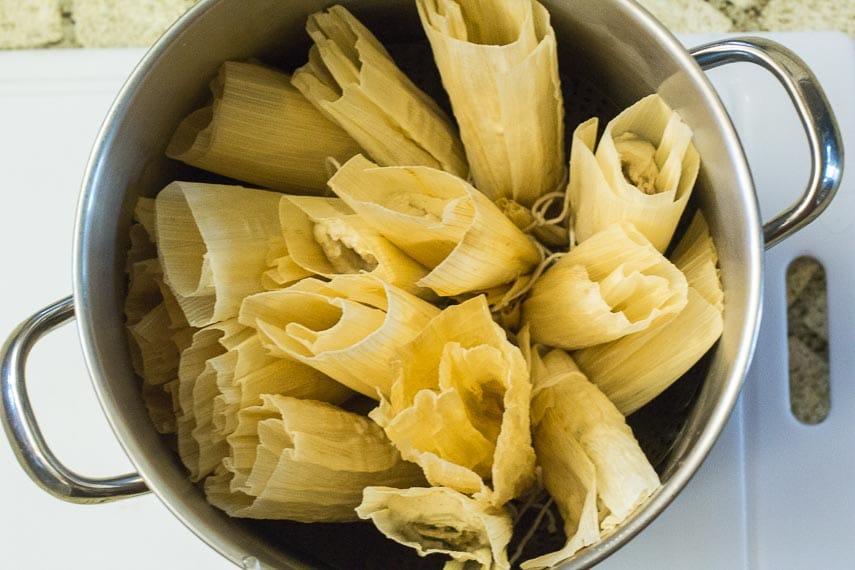
Another popular Hispanic food with a rich history, tamales hail from Mesoamerica, so they’re shared by Mexico, Costa Rica, and Nicaragua. Despite the shared Hispanic culture, tamales are most commonly associated with Mexico since Mexican recipes have infiltrated non-Hispanic nations.
Authentic Mexican-style tamales are meat and vegetable-filled masa dough wrapped in a corn husk and steamed until cooked. Nicaraguan tamales are called nacatamal and contain garlic, onions, bell pepper, and meat filling steamed in banana leaves and eaten with a cup of coffee and bread. Costa Rican recipe shares its roots with other Central American nations and the Caribbean coast.
It’s hard to find authentic tamales in the United States since there is no one recipe to nail this Hispanic food; most eateries serve recipes derived from different nations, so they’re delicious in their own ways.
17. Bandeja Paisa: Colombia
Colombians aren’t afraid of spicing it up, so bandeja paisa is one of the tastiest foods across Latin American countries. Bandeja paisa isn’t a one-man army; it gets its exquisite flavor from a plethora of ingredients.
Traditional bandeja paisa platter includes boiled white rice, chicharron, pork, fried red beans, plantain, arepa, chorizo, sunny-side up, blood sausage, avocado, and a thick, creamy hogao sauce. The savory dish is praised for its palatable quality, which is what prompted the Colombians to make it their national dish. There’s really no other Colombian food that offers as diverse and divine flavor as bandeja paisa.
18. Pabellon Criollo: Venezuela
Slightly similar to bandeja paisa, Venezuelan pabellon criollo is a delectable Latin American food, although it has fewer items. Pabellon criollo is a rice-based platter typically containing shredded beef stew, beans, and rice.
Pabellon criollo doesn’t have many variations outside of Venezuela, but it deviates from authentic recipes when it reaches the continental Caribbean coast. Caribbean Venezuelan pabellon criolo substitutes beef with fish or even caiman meat and has even used capybara across locations. Some variations also include fried plantains.
Whatever the toothsome variation, one simply cannot resist a bite.
19. Plantain mangu: Dominican Republic
The national dish of the Dominican Republic, this Hispanic dish gives a completely new perspective to simple foods. Mangu is a plantain-based dish made by cooking the vegetables and then mashing them until they churn into a smooth, fine texture. The simple dish is like lump-less mashed potatoes, although they’re served with sauteed red onions.
Mangu sounds boring, but it’s actually quite rich. The original recipe has been modified over time, so there are variations that use other vegetables like squash and add eggs, salami, and fried cheese.
20. Llapingachos: Ecuador
Llapingachos are like hash browns, only richer, thicker, and better. These Ecuadorian potato pancakes are incredibly easy to make and are abundantly served in Hispanic restaurants, even in the U.S.
The potato cakes are filled with cheese and onions, which are ingredients from the original recipe, but Ecuador itself has various recipes for the dish. Some variations use chorizo, tomatoes, pork, and eggs, while others may combine a few Hispanic ingredients and may be served with sauces.
Their simple exterior hardly speaks for their lip-smacking taste, which is why many tourists exploring the South American country can’t help but buy in bulk.
21. Saltenas: Bolivia
A savorous cross between Mexican empanadas and pies, saltenas are baked pastries that derive from Bolivia. This Bolivian dish boasts a scrumptious combination of pork, beef, or chicken lined with olives, potatoes, and raisins baked into a crispy dough.
An Argentinian immigrant in Bolivia created the dish, so many believe the dish shares cultural roots with the other South American nation. However, there are multiple variations of saltenas across Bolivia, including all-veg recipes.
Saltenas aren’t dry; they’re usually lined with a rich, juicy sauce which gives them a sweet, tangy kick. They’re truly a delight to eat.
22. Sopaipillas: Multiple
This Hispanic food has so many variations it can’t be linked to Latin or South America, let alone one nation. Sopaipillas are a fried pastry, although they have a bread-like soft texture.
This amazing Hispanic food is made by thinly rolling wheat dough with butter, cutting it into triangles or squares, and frying the dough until it puffs.
Sopaipillas can be sweet, savory, or both. Peruvian sopaipillas are sweet and may be paired with a tangy sauce, while Chilean sopaipillas are savory and topped with spicy hot syrup and even cheese.
The United States prefers sweetened sopaipillas, much similar to donuts, and even shares recipes with toaster strudel.
23. Picadillo: Cuba, Puerto Rico
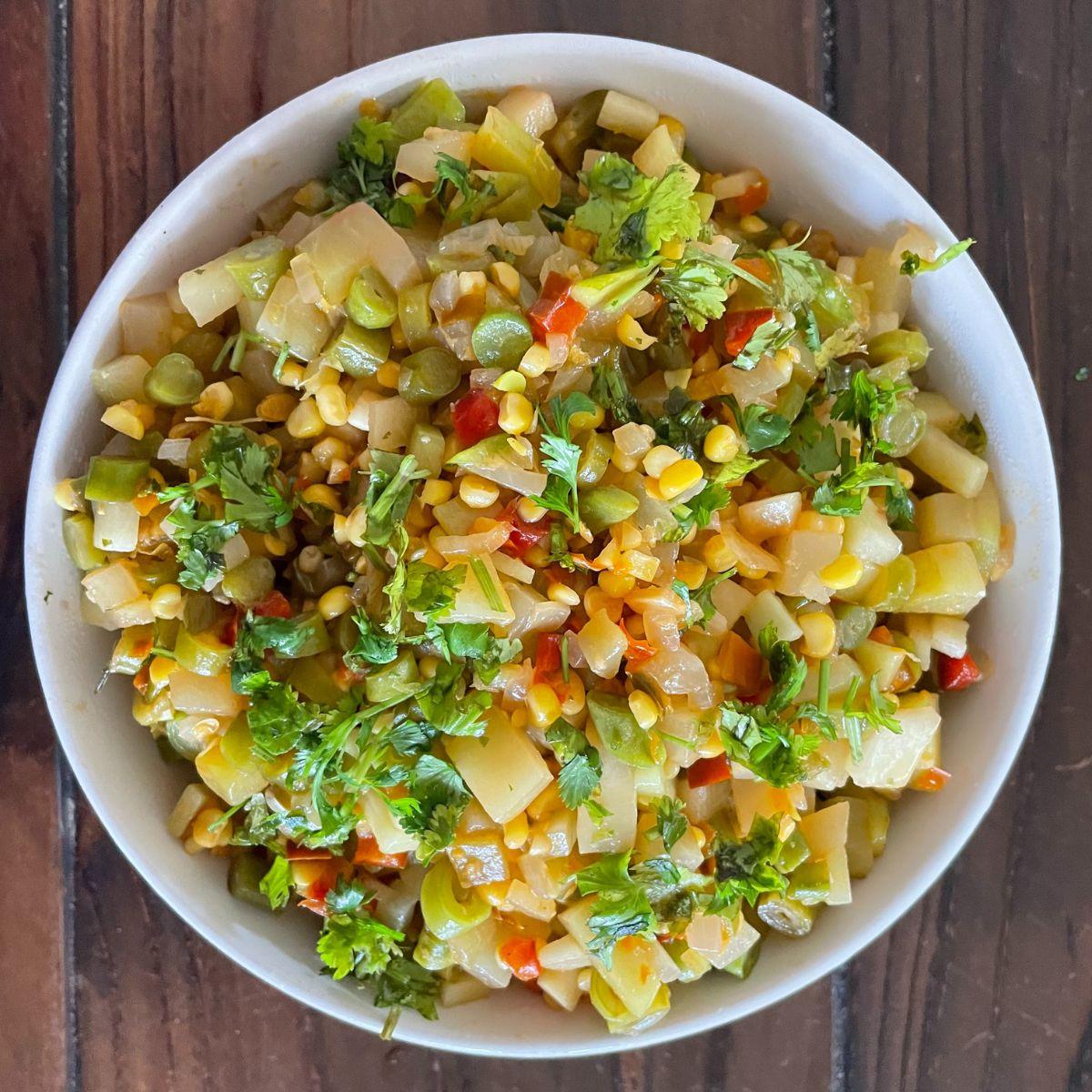
Originating in Latin American Cuba and Puerto Rico, picadillo is a savory ground meat dish cooked with tomatoes and served over rice. Picadillo is one of the only Hispanic foods that share roots with Asian countries like the Philippines.
Original Latin American recipes may include bell peppers, olives, chicken stock, herbs, beans, garlic, and onions served with rice or tortillas.
The Filipino version of picadillo is soupier and may include chayote served over rice. Some say picadillo shares ideas with the South Asian minced meat recipe, only those who have tried both can tell.
24. Pepian: Guatemala
A plane ride to Guatemala ends with aromatic servings of pepian – the Guatemalan national dish consisting of a rich curry-like stew that typically includes slow-roasted beef, tomatoes, Mexican husk tomato (tomatillo), chilis, and herbs.
Pepian uses gourd seeds as a thickening agent, so they have an intense, earthy flavor that serves as a heavenly gourmet meal. It can be enjoyed plain or served over rice or with bread. It is quite close to the Mexican pipian verde.
25. Chaja: Uruguay
Hispanic and Latin American cuisines are fond of spices, but they’re not strangers to sweet delights. Chaja is a cake-like dessert originating in Uruguay, though various inspired recipes exist around the world.
Chaja is a layered sponge cake topped with cream, meringue, and fruits. Some variations of chaja may add dulce de leche or chocolate, but the original recipe dominates.
Chaja is typically served in bakeries in Uruguay, but its recipe can easily be replicated at home.
26. Matambre arrollado: Argentina
Matambre arrollado might not look appetizing, but it’s one of the most savorous and nutritious Hispanic dishes. The Argentinian delight is made by stuffing thin flank steak with hard-boiled eggs, red bell peppers, and chorizo.
The delectable mix is then rolled like a sheet cake, baked together, and thinly sliced to give individual meals.
Although the dish is primarily served in Argentina, variations of the recipe seek inspiration from Mexican cuisine. Some recipes use chimichurri sauce in the steak or as a side.
Explore the rich tapestry of Hispanic cuisine and savor these diverse and delicious dishes from Spain, Latin America, and beyond!
This article originally appeared on Pink When.
Author
-
With a background in hospitality and years of experience in the restaurant industry, Nandor founded My Pure Plants with a mission to spread the word about delicious vegan cooking. He believes in the importance of cooking from scratch and avoiding processed and artificial foods, making each meal an opportunity to nourish both the body and the soul. He co-authored two cookbooks titled Express Vegan Cooking and Vegan Winter on a Budget.